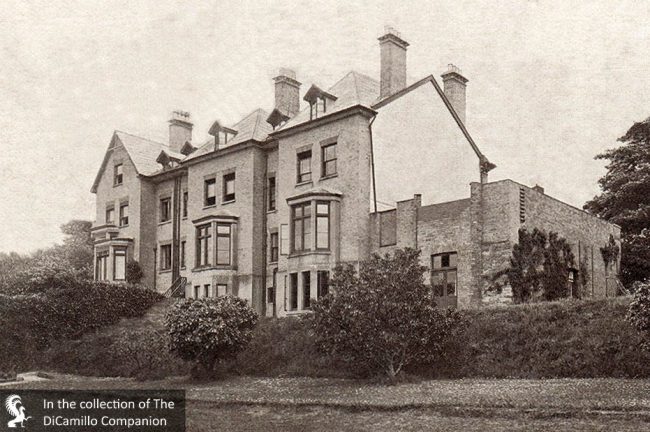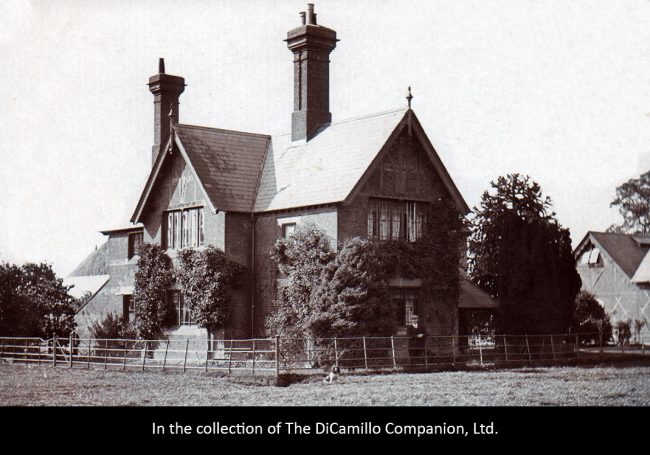
The house from a circa 1922 postcard

An estate cottage from a circa 1912 postcard
Earlier Houses: There was an earlier house of the Hyde family on the site of the current house, parts of which were incorporated into today's house.
House & Family History: Pevsner says, in "The Buildings of England: Berkshire," that the core of the current Haineshill is a late 16th century house built on an H-plan with a number of courtyards. Most of Haineshill, as seen today, was built circa 1630 for Sir Francis Windebank, secretary of state to Charles I and a friend of Archbishop Laud, who frequently visited the house. Haineshill is noted for its Long Gallery, which is similar to that at Bramshill House in Hampshire, and its fine interiors of circa 1716 and circa 1760. In 1640, during the Civil War, Sir Francis, a supporter of the king, was arrested by order of parliament, but managed to escape to France, where he died six years later. Considered a traitor during the commonwealth, his estates were seized and sold to Richard Bigg, a parliamentary supporter. Haineshill remained the seat of the Biggs family until 1736, when it was sold to James Edward Colleton, husband of Lady Ann Cowper, daughter of the 1st Earl Cowper. It was Colleton who added the nine-bay entrance façade, with its three-bay pediment, to the house in 1760. When he died in 1790 Colleton left no direct male heirs, so the estate passed to Charles Garth, the grandson of his second cousin (their common ancestor was the first baronet, Sir John Colleton, after whom Colleton County in South Carolina was named). Garth (later Garth-Colleton) was, interestingly, the colonial agent for South Carolina, Georgia, and Maryland. On his death in 1818 Haineshill went to his brother, Capt. Thomas Garth, RN, who added the Servants' Wing in 1825 (demolished 1963) and the Stables and Coach House in 1838. His son, Thomas Colleton Garth, was the founder of the Garth Hunt, which held its opening meet at Haineshill on November 8, 1852. After his death in 1907, the estate passed to his sister, who lived for only three years as chatelaine of Haineshill; at her death the estate passed to her nephew, the Welshman Capt. William Charles Godsal, a younger brother of the inventor of the anti-tank rifle and one of the Godsals of Iscoyd Park. For most of the early 20th century the house served as a school, firstly as Haines Hill School and, during World War II, as Eaton House Preparatory School.
Architect: Charles Fowler
Date: 1838John Bernard (J.B.) Burke, published under the title of A Visitation of the Seats and Arms of the Noblemen and Gentlemen of Great Britain and Ireland, among other titles: Vol. I, p. 108, 1852.
Title: Buildings of England: Berkshire, The
Author: Pevsner, Nikolaus
Year Published: 1966
Reference: pg. 210
Publisher: London: Penguin Books
ISBN: NA
Book Type: Hardback
House Listed: Grade II*
Park Listed: Not Listed
Current Seat / Home of: Godsal family; here since 1910.
Possible Seat of: Servants' Wing demolished in 1963
Past Seat / Home of: SEATED AT EARLIER HOUSE: Hyde family. SEATED AT CURRENT HOUSE: Sir Francis Windebank, 17th century. Richard Bigg, 17th century; Biggs family here from 1646 until 1736. James Edward Colleton, 18th century; Charles Garth-Colleton, until 1818; Capt. Thomas Garth, RN, early 19th century; Thomas Colleton Garth, until 1907.
Current Ownership Type: Individual / Family Trust
Primary Current Ownership Use: Private Home
House Open to Public: No
Historic Houses Member: No